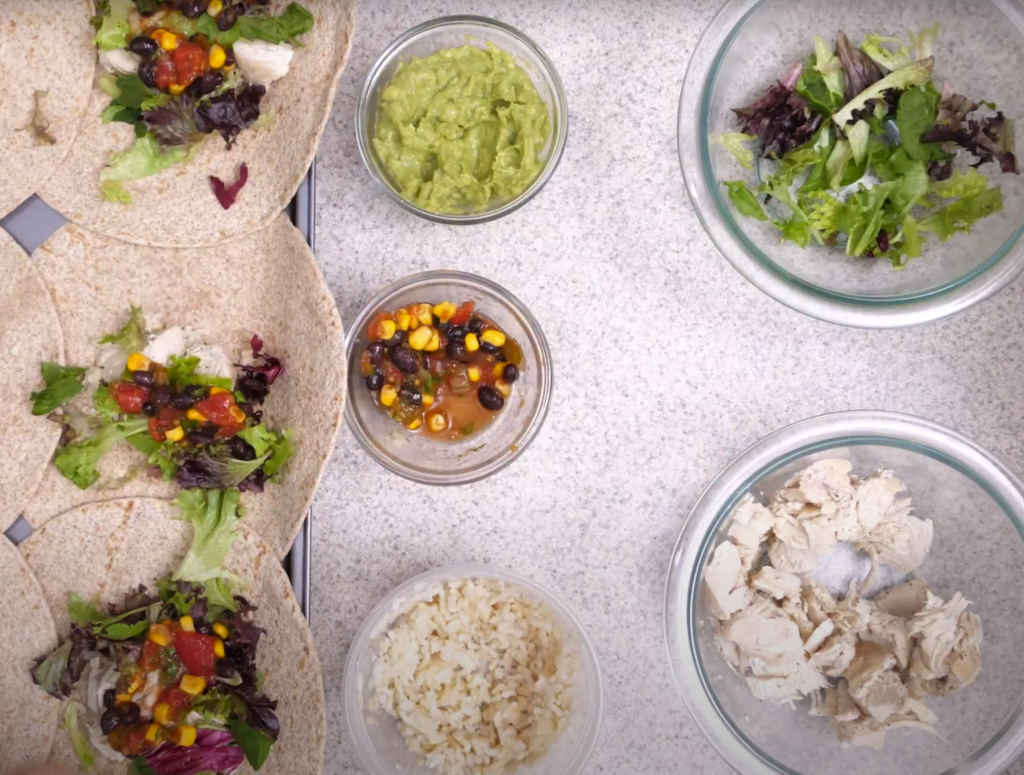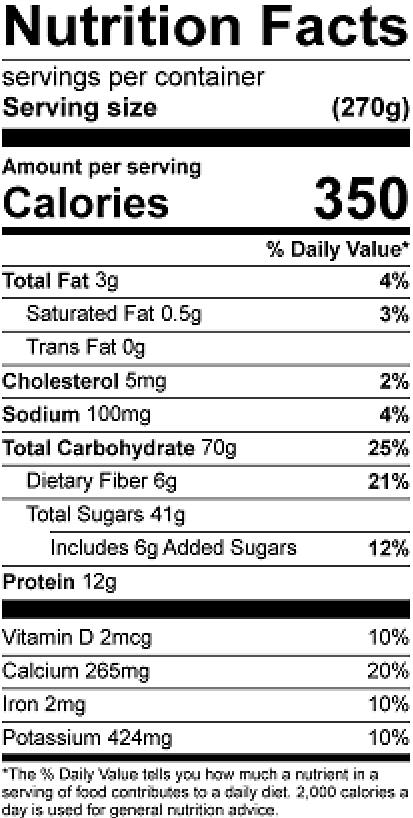Chicken and Bean Burrito

Makes 6 servings | Serving Size: 1 burrito
Directions
Ingredients:
- 6 whole wheat tortillas (12 inch)
- 1 cup cooked brown rice
- 2 cups cooked chicken, diced
- 1/2 cup Black Bean and Corn Salsa (see below)
- 2 cups coarsely chopped saladgreens
- 1/2 cup cheddar cheese,shredded (or other cheese)
- 1 avocado, chopped
Directions:
- Warm tortillas in oven following package directions.
- Leaving 1″–2″ of space from end of tortilla, divide ingredients and layer ontoone end of 6 tortillas in the following order: rice, chicken, salsa, greens, andcheese.
- Fold tortilla over filling, pressing gently so that filling moves down into the fold.
- Wrap both right and left side ends of tortilla over fold.
- Roll tortilla to close.
Nutrition Information Per Serving
336 Calories, Total Fat 15g, Saturated Fat 5g, Protein 21g, Total Carbohydrate 32g, Dietary Fiber 8g, Sodium 455mg. Excellent source of Vitamin A. Good source of iron.
BLACK BEAN AND CORN SALSA
Makes 24 servings
Serving Size: 1/4 cup
Ingredients
• 1 (16-ounce) jar salsa
• 1 (15.5-ounce) can unsalted black beans, drained and rinsed
• 1 (15.5-ounce) can unsalted corn kernels, drained or 11⁄2 cups frozen
• 1 (14.4-ounce) can low-sodium chopped tomatoes, drained
• 2 tablespoons lemon juice
• 1/4 teaspoon garlic powder
• 2 tablespoons chopped fresh cilantro or 1 teaspoon dried (parsley may be substituted)
• 1/2 teaspoon ground cumin
Directions
- Combine all ingredients in a medium-size bowl.
- Cover and chill for 30 minutes before serving.
- Serve with chips or as a vegetarian side dish.
Nutrition Information Per Serving
35 Calories, Total Fat 0g, Saturated Fat 0g,
Protein 1g, Total Carbohydrate 8g, Dietary
Fiber 1g, Sodium 190mg
Ranch Dip
Try cucumbers as a snack with hummus, on a salad, or with other dips like our ranch dip here!
Makes 4 servings | Serving size: 1/4 Cup
Ingredients
- 1 cup plain greek yogurt
- 1 teaspoon garlic powder
- 1 teaspoon onion powder
- 1 teaspoon ground black pepper
- 1 tablespoon dried parsley
- 1 tablespoon dried dill weed
- 2 teaspoons white distilled vinegar
Directions
- Combine all ingredients in a bowl.
- Mix well and enjoy!
National Spinach Day
March 26th is National Spinach Day! Spinach contains many helpful nutrients, but it is especially high in iron, Vitamin K, Vitamin C, and Vitamin A.
– Iron is an important building block in our blood. It helps move oxygen from the lungs to the rest of the body. If you don’t have enough iron, it could lead to anemia, which may make you feel tired and short of breath.
– Vitamin K helps maintain healthy bones. It also plays an important role in healing wounds or cuts. If you don’t have enough Vitamin K, it could prevent your scratches and bruises from healing properly.
– Vitamin A helps with eyesight, growth, and development, so it’s especially important for kids to get the right amount! It also plays an important role in keeping many of our organs working properly. Most Americans get enough Vitamin A, but it’s still important to keep track and make sure you are getting enough.
– Vitamin C is another important building block in the body that is needed for healthy bones, skin, cartilage, and blood vessels. It also helps build your immune system, and it helps our bodies absorb iron! If you don’t have enough Vitamin C, you could develop scurvy, which can cause bruising, fatigue, and rashes.
All in all, spinach is a great food to work into your diet to help you get the nutrients you need to stay strong and healthy! It can be eaten raw in salads or sandwiches; blended and added to smoothies or dips; cooked into soups, sauces, and casseroles; or cooked and eaten as a side dish! Feel free to give this spinach omelet recipe a try!
*If you are worried about getting the right amount of nutrients in your diet, or if you are experiencing any worrying symptoms, talk with your doctor.
Sources: Dietary Guidelines and BBCgoodfood
Green Eggs and Ham Muffins
Makes 12 servings | Serving Size: 1 muffin
Ingredients:
• Nonstick cooking spray
• 1 tablespoon olive oil
• 1 cup finely diced sweet onion
• 1/2 cup finely diced lean ham
• 1 cup finely diced mushrooms
• 2 cups finely chopped baby spinach (long stems removed) • 12 eggs (6 whole, 6 egg whites)
• 3/4 cup low fat cheddar cheese, shredded
• Salt and pepper to taste
Directions:
- Preheat oven to 375 F. Spray muffin tin with cooking spray.
- Place olive oil in skillet and heat over medium high heat.
- Add onion, ham and mushrooms to skillet. Cook untiltender, stirring constantly.
- Stir in baby spinach. Cook until just wilted.
- Drain. Use paper towels to remove all water from cookedmixture.
- Spoon 1 tablespoon of meat and veggie mixture intoeach muffin cup.
- Using an electric mixer, beat egg whites until foamy.(Room temperature egg whites work best.)
- In a separate bowl, whisk together remaining 6 eggs withsalt and pepper to taste.
- Gently fold beaten egg whites into whole eggs.
- Using a cup with a spout, pour egg mixture in eachmuffin cup until almost to the rim of the cup.
- Spoon 1 tablespoon cheese over mixture
- Gently stir each cup with a fork and bake for 22 minutesor until internal temperature reaches 160 F.
Nutrition Information Per Serving
121 Calories, Total Fat 7g, Saturated Fat 3g, Protein 10g, Total Carbohydrate 4g, Dietary Fiber 1g, Sodium 179mg. Excellent source of vitamin A.
Recipe contributed by Carol Pitts, NC EFNEP Educator
Overnight oats
Ingredients:
- 3/4 cup skim or 1% milk
- 1 teaspoon honey
- 1 dash of cinnamon
- 1/2 cup old fashioned oats (not quick oats)
- 1/4 cup raisins
- Chopped nuts (optional)
Directions:
- Combine all ingredients in a jar
- Shake
- Place in the fridge overnight
